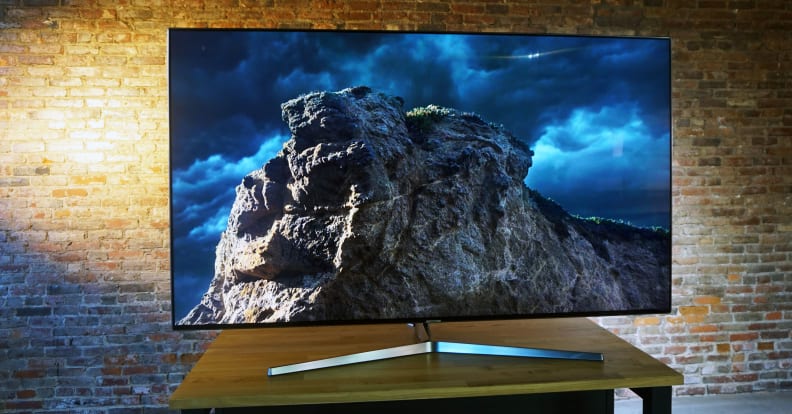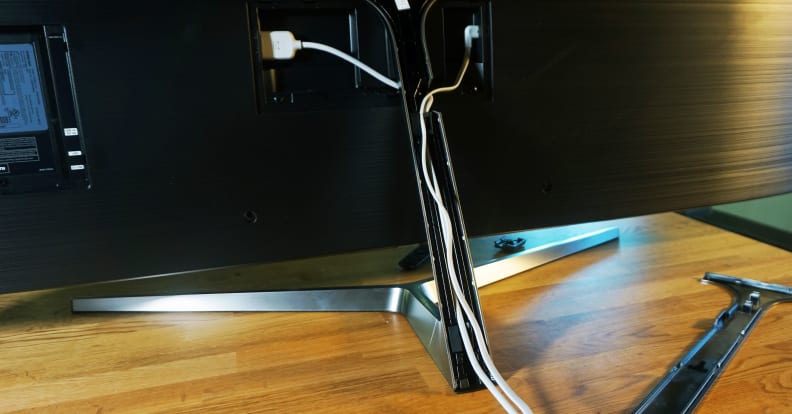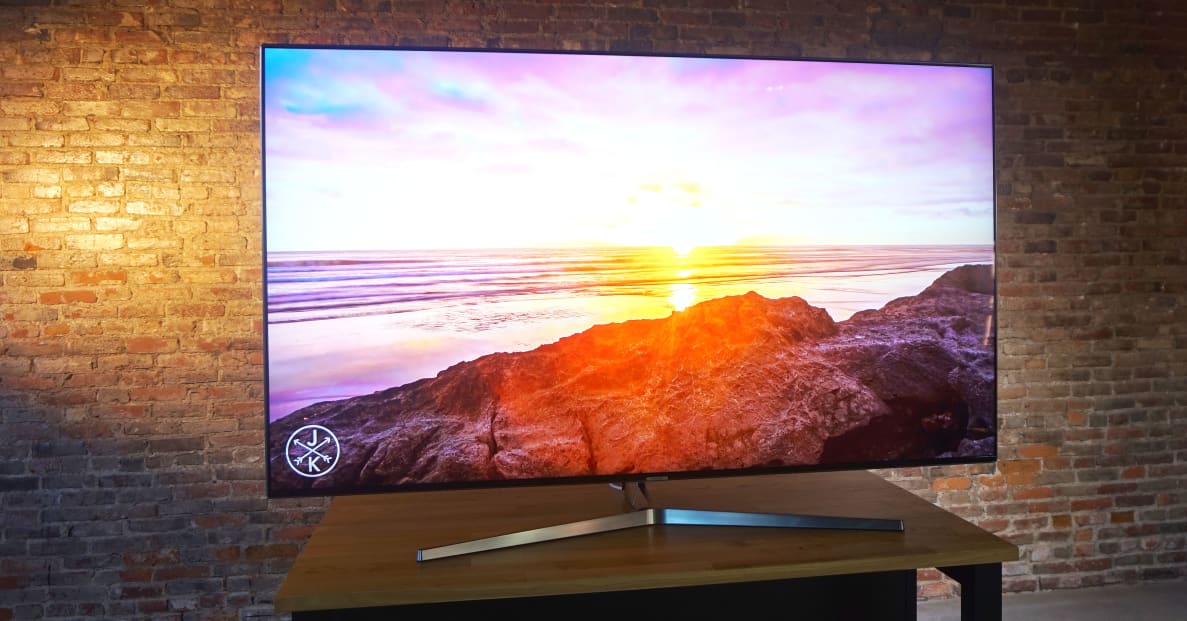Pros
Cons
While it's not exactly a "cheap" option, Samsung's MU9000 Series does promise to deliver a bevy of impressive-sounding features. The MU9000 lives one rung on the ladder below Samsung's Q7F QLED series, but between the 65-inch in both series, the MU9000 is almost $1,000 more affordable.
While it might be a little pricier than most buyers would like, you can't argue with this TV's quality. Testing revealed a huge set of advantages, including excellent picture quality, a good smart platform experience, and very attractive design elements. Drawbacks are minimal, meaning only HDR-crazy buyers will want to up the ante and buy into the brighter, more colorful Samsung QLEDs.
About the MU9000 Series
{{ amazon name="Samsung UN65MU9000 4K UHD TV", asin="B06XGCT2PQ", align="right" }}
Samsung's MU9000 series TVs are available in three screen sizes:
• 55-inch (Samsung UN55MU9000), $1,300 • 65-inch (Samsung UN65MU9000), $1,800 • 75-inch (Samsung UN75MU9000), $3,300
The MU9000 TVs are distinctly not QLED models: they don't feature the color-boosting quantum dots that make Samsung's QLED series (like the Q7, Q8, or Q9 TVs). Otherwise, the MU9000 TVs deliver a robust feature set—which we'd expect for these prices:
• 4K resolution (3,840 x 2,160) • High Dynamic Range (HDR10) compatibility • 120 Hz refresh rate • Smart Hub (internet/apps) built in • Edge-lit LED backlight with software dimming
As one of Samsung's premium 4K/HDR TVs this year (and the best of its non-QLED series), the MU9000 delivers many of the same goodies and attention to detail as the higher-end QLED models. You're paying for reliable and attractive design, robust smart features, HDR, 4K, and a suite of picture enhancements.
We received the 65-inch MU9000 on loan from Samsung, and gave it 24 hours of warm-up and break-in time prior to watching, calibrating, and reviewing it.
What We Like
A svelte design that's pretty from any angle
Our 65-inch MU9000 is a really good-looking TV, which I was hoping would be the case considering it's $1,800. The flat, silver-bezeled panel perches on a sturdy, Y-shaped tabletop stand, but you can also wall-mount it. The rear chassis is made of a smooth, attractively finished plastic that features some impressive cable-management and minimalist systems.

This minimalist approach is made possible by the inclusion of the OneConnect box, an external mainboard component that houses the MU9000's HDMI inputs, USB ports, and so on. The OneConnect box connects to the MU9000 by a six-foot cable. This means the only thing plugged into the TV should be the OneConnect box and the TV's power cable. A cable-guide slot in the base allows both cables to be routed through the stand and out behind the TV, adding to the clutter-free aesthetic the TV seems to be aiming for.

Likewise, the included remote is slick and simple, sporting as few buttons as Samsung could get away with. Outside of directional keys, a center select button, and rockers for channel/volume, there's not much else going on. All in all, the whole package here is highly polished and attractive.
Bright, colorful, 4K glory
At a glance, the MU9000 is a very impressive set. Samsung has been the leader in super-bright HDR TVs this year, and the company's top 4K UHD series is no exception. While it's not quite as ridiculously bright and colorful as the pricier QLED options, it still delivers a very impressive picture.

The first thing I noticed about the MU9000 after turning it on and getting some test patterns on the screen was how good its contrast is, specifically its black level production. While we're expecting most of Samsung's HDR-ready LED TVs this year to deliver a hefty dose of brightness, getting good black levels is trickier.
This is mostly due to the fact that the MU9000 TVs are "edge-lit," meaning their backlights light the entire screen from the perimeter rather than spanning the entire rear side of the screen like with full-array LED TVs. While edge-lit TVs have traditionally performed worse than their full-array counterparts in terms of black level production and screen contrast, the MU9000 is an exception.

During our standard contrast test in Movie mode, I measured an average black level of 0.032 nits and a reference brightness of 196.70 nits. This gives the MU9000 a contrast ratio (in SDR mode) of over 6000:1, which is very good for an edge-lit LED TV. Likewise, despite being an edge-lit model, the MU9000 does an excellent job maintaining its highlight and shadow levels across differing APLs (average picture levels).
However, this TV's strongest point is most certainly its out-of-the-box core performance where color accuracy, white balance, and gamma are concerned. In Movie mode, the MU9000 delivers almost flawless rec.709 (standard color) adherence and tight-nit RGB emphasis/low levels of error across the grayscale. While you could still get a little extra mileage from hiring a professional calibrator, it's surprisingly well-tuned out of the box.
What does this mean in plain English? You can plug the MU9000 in, boot up Netflix or a DVD or Blu-ray, and it's going to look pretty awesome no matter what you throw at it.
Not the year's very best HDR TV, but a dang good one
Where HDR-ready LED TVs go, Samsung has been kicking butt this year. The company's pricy but impressive QLED models (Q7, Q8, Q9) blew us away with 1000-1,500 nit peak brightnesses and color spaces that just about hit 100% of the new DCI-P3 color gamut, a color space utilized by HDR that delivers a much wider and more saturated range of color.
Because it doesn't have the quantum dots that put the "Q" in QLED, the MU9000 doesn't quite stack up to Samsung's pricier models. But that's not to say it doesn't deliver a good HDR picture. I measured peak HDR brightnesses around 650 nits, usually coupled with black levels around 0.1 nits. While those black levels aren't amazing, it's very likely you won't notice them when they're coupled with blisteringly bright specular highlights and average screen brightnesses above 400 or 500 nits.

Where the MU9000 falls a bit short is in coverage of the DCI-P3 gamut. While it sports a good deal of extra color saturation during HDR content, it doesn't quite match top QLED and OLED models we've tested this year. Even still, by our estimation it clears 90% of DCI-P3, and that's still a very solid result.
This means you can expect HDR content to not only be satisfyingly bright, but also beautifully colorful. Whether you're watching HDR content on Netflix or indulging in one of the many excellent HDR Blu-rays out there, you can expect to be impressed by the MU9000—assuming you're not used to an even higher-pedigree HDR set.

A 120 Hz panel and adjustable motion? Yes please
We've established that the MU9000 produces a rather excellent picture, whether that be traditional ("SDR") content or new bright/colorful HDR content. However, it's one thing to create sharp, colorful, contrasting images that are still, and altogether another to maintain their integrity during motion.
Fortunately, the MU9000 TVs have 120 Hz refresh rates. Currently, TVs come in two "flavors" of refresh rate: 60 and 120 Hz. While 60 Hz TVs are fine for almost all broadcast and streaming content, they are sometimes less ideal for mediums like Blu-ray discs (which typically play at 24fps) and video games (which introduce the element of translating input from your controller to the screen). The MU9000's 120 Hz refresh rate means you won't have to worry about Blu-ray judder, and it should offer good input lag results in Game mode, too.
If you aren't satisfied by the MU9000's motion performance, the TV also has adjustable motion settings. There are presets, like "Clear" and "Smooth," which automatically employ the TV's built-in de-judder and de-blur effects. But you can also select "Custom" and set them yourself. While it would be a pain to go in and design motion settings for every kind of content you enjoy, the added flexibility is still very welcome, especially for viewers who are sensitive to motion issues.
The Smart Hub continues to feel... intelligent
Beyond its svelte design and excellent picture quality, the MU9000 also adds some value via its included smart features. Samsung has been refining and improving the "Smart Hub" for a number of years, and while we still prefer third-party streaming options such as the Roku platform or Apple TV, the Smart Hub certainly doesn't detract from the TV's overall polish.
The Smart Hub will give you access to the premium apps right away: Netflix, YouTube, Amazon Video, and the like. While you likely already have some method of accessing those apps, the advantage to logging in through the MU9000 is that you'll be able to stream 4K/HDR content (provided you've paid to access that content). The Smart Hub can also be easily programmed to display live cable content, and is even smart enough to identify and interface with most of the devices you connect over HDMI. It'll know if you've plugged in an Xbox One or a Blu-ray player, and change the name of the input automatically.
All in all, it's a very cool/welcome system, though its saving grace remains the ability to stream 4K and HDR content right out of the box. While third-party streaming boxes are rapidly catching up, unless you've got one of the newest Roku/Amazon Fire type options or a very pricy Blu-ray player, the Smart Hub might be your only way to experience this TV at its best. At least, for a little while.
What We Don't Like
Narrow viewing angles limit usability
While Samsung's edge-mounted LEDs do a lot right, providing high brightness and excellent contrast, edge-lit sets still have a few hurdles they tend to run into, and one of them is limitations to horizontal viewing angle. Particularly, while black levels and shadow details are satisfyingly dark when viewed head on, they fall off and become brighter and grayer very quickly when the TV is viewed away from center.
During testing, I measured a total horizontal viewing angle of around 26°, or ±13° from the center to either side of the screen. This makes for very limited viewing, and sitting too far to either side of the screen will give the picture a somewhat washed-out appearance. While this is an unfortunate drawback, it's also usually to be expected for edge-lit LED TVs—no matter how good they are otherwise.
Luminance levels can be rough around the edges
This one's a bit harder to explain, and is likely only something that's going to bother picky/sensitive viewers. However, because of its edge-mounted backlight, the MU9000 is programmed and pre-set to deliver luminance signal levels at particular voltages correctly concurrent to a particular amount of light on the screen (APL). Basically, its gamma is programmed to adhere to around 18–25% APL, and doesn't always scale properly when more or less of the screen is bright.

This isn't a unique issue. In fact, I'm willing to bet whatever TV you have now has imperfect gamma, unless you've had it professionally calibrated. However, it's a bit worse on the MU9000 than on some competing models this year. Nothing that most viewers are likely to notice, but it's worth mentioning if only because it's one of the MU9000's very few flaws.
Should You Buy It?
Yes, if you're really excited about HDR
The MU9000 TVs are great, but they aren't without competition. With prices ranging from $1,300–$3,300, there's no way to get one of the MU9000 TVs for what we'd call a "cheap" price. If you're looking for a smart, 4K, HDR-compatible set with decent performance, you could save $600 by going with the 65-inch Vizio M Series. While it's not quite on the same level as the MU9000 for HDR (it's about half as bright), it's similar in other regards.
However, if you're really looking to future-proof, and hope to be watching nothing but 4K/HDR content in a year or two, we recommend investing in one of the MU9000 TVs over cheaper alternatives. Where HDR is concerned, brightness is key to unlocking both the magic of higher dynamic range (hence the name) as well as brighter, more saturated colors. This is a major reason the MU9000 TVs are priced as they are, so if HDR is what you've got your sights set on, there's no reason not to take the plunge. As I said on the front page, the MU9000 tested with commendable results both during SDR and HDR performance. While it has some issues with gamma, overall the MU9000's core performance is very good. In both standard ("SDR") and HDR modes, I measured low levels of grayscale discrepancy, tight-knit RGB emphasis, and accurate color (for both hue/saturation).
SDR Results




HDR Results




Meet the tester
Lee was Reviewed's point person for most television and home theater products from 2012 until early 2022. Lee received Level II certification in TV calibration from the Imaging Science Foundation in 2013. As Editor of the Home Theater vertical, Lee oversaw reviews of TVs, monitors, soundbars, and Bluetooth speakers. He also reviewed headphones, and has a background in music performance.
Checking our work.
Our team is here to help you buy the best stuff and love what you own. Our writers, editors, and experts obsess over the products we cover to make sure you're confident and satisfied. Have a different opinion about something we recommend? Email us and we'll compare notes.
Shoot us an email


